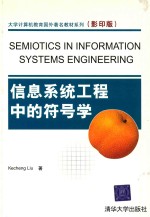

信息系统工程中的符号学 影印版PDF电子书下载
- 电子书积分:10 积分如何计算积分?
- 作 者:KechengLiu著
- 出 版 社:北京:清华大学出版社
- 出版年份:2005
- ISBN:7302099626
- 页数:223 页
1 Introduction 1
1.1 Information and information systems 1
1.2 Problems and challenges in information systems 2
1.3 Approaches and methods for information systems development 5
1.4 MEASUR:a semiotic approach to information systems 7
1.5 About this book 8
Part one Semiotic framework and methods 11
2 Understanding semiotics 13
2.1 Signs and their functions 13
2.2 Semiosis and learning 15
2.3 Semiotics in computing 17
2.4 Semiotics in organisations and information systems 19
3 A semiotic framework for information systems 21
3.1 Philosophical stance 21
3.1.1 Objectivist paradigm 21
3.1.2 Subjectivist paradigm 24
3.1.3 Radical subjectivist paradigm 26
3.2 The semiotic framework 26
3.2.1 Physics 27
3.2.2 Empirics 28
3.2.3 Syntactics 29
3.2.4 Semantics 30
3.2.5 Pragmatics 31
3.2.6 The social level 33
3.3 An example of semiotic analysis 35
4 A semiotic approach to information systems development 37
4.1 MEASUR 37
4.2 How MEASUR can help in information systems development 39
4.2.1 Infrastructure analysis 40
4.2.2 Systems analysis,design and implementation 46
4.3 Summary 47
5 Knowledge representation and information analysis 49
5.1 Some basic considerations in knowledge representation 50
5.1.1 Expressive adequacy and notional efficiency 50
5.1.2 Semantic primitives 50
5.1.3 Types of knowledge 51
5.2 Representation approaches 52
5.2.1 Typical examples 52
5.2.2 Conceptual graphs 54
5.3 Some fundamental issues of information analysis 56
5.4 The role of information analysis 58
6 Semantic Analysis 61
6.1 Theoretical aspects of Semantic Analysis 61
6.1.1 Affordances 61
6.1.2 Ontology and some other fundamental notions 63
6.2 NORMA 64
6.2.1 Well-formed formula 65
6.2.2 Affordance and ontological dependency 65
6.2.3 Semiotic behaviour 67
6.2.4 Time 67
6.2.5 Determiner and identity 68
6.2.6 Generic-specific relationship 68
6.2.7 Defining authority and responsibility 69
6.2.8 Graphic representation-ontology chart 69
6.3 Using LEGOL to specify Norms 71
6.4 Conducting a Semantic Analysis 73
6.4.1 Understand the problem domain 74
6.4.2 Generating candidate affordances 75
6.4.3 Candidate grouping 76
6.4.4 Ontology charting 78
6.4.5 Norm Analysis 79
6.5 Commentary on Semantic Analysis 80
7 Pragmatics and communication 82
7.1 Hunan communication 82
7.2 Other approaches to communication 83
7.2.1 Speech Act Theory 83
7.2.2 Functional approach 86
7.2.3 Deontic logic for communication 89
7.3 Pragmatic aspect of human communication 94
7.4 The Norm Analysis method 98
7.4.1 The concept of norms 98
7.4.2 Norms in business organisations 100
7.4.3 Norm Analysis 102
7.4.4 Norms in computer systems 106
8 The social layer:modelling organisations as information systems 108
8.1 Organisations as information systems 109
8.2 The notion of responsibility 111
8.3 An organisational morphology 112
8.4 Modelling the organisation 113
8.5 Summary:requirements for an effective information modelling method 114
Part two Applications 117
9 From semiotic analysis to systems design 119
9.1 The semantic aspect of databases 119
9.2 Capturing the semantic aspect 120
9.3 Capturing the time aspect 121
9.4 Ontological modelling for conceptualisation 123
9.5 Intentions,propositional attitudes and consequent operations 124
9.6 Other aspects of databases:facts,beliefs,and knowledge 125
10 Semantic temporal databases 133
10.1 Databases 133
10.1.1 Developments in database management systems 133
10.1.2 Semantic temporal databases 136
10.2 The semantic templates 138
10.2.1 Defining a semantic template 138
10.2.2 ST for database design 139
10.3 Systems construction 142
10.4 LEGOL 143
10.4.1 Basic syntactic structure 143
10.4.2 Some important operations 145
11 Normbase:a new approach to information management 150
11.1 The Normbase concept 150
11.2 The Normbase system 152
11.2.1 The Normbase engine 152
11.2.2 The semantic temporal database 154
11.2.3 The norm store 155
11.3 Information management with the Normbase system 156
11.4 Using semiotic methods with other approaches 157
11.4.1 Relational database for implementation 158
11.4.2 Object-oriented methods for design and implementation 159
12 Case study:development of a land resources information system 164
12.1 Background 164
12.2 Semantic Analysis for requirements modelling 165
12.3 Norm Analysis 171
12.4 System design and implementation in the Normbase approach 174
12.5 Discussions and conclusions 179
13 Case study:development of a test construction system 180
13.1 Background 180
13.1.1 CONTEST project 180
13.1.2 User requirements 181
13.1.3 Why choose Semantic Analysis? 184
13.2 System analysis 186
13.3 System design 190
13.4 System construction 194
13.5 Discussion and conclusions 194
Appendix A Semantic templates and surrogate specification 196
A.1 Definition of ST 196
A.2 Examples of using ST in discourse modelling 197
A.3 Examples of surrogates 199
Appendix B LEGOL applications in the CRIS case 201
B.1 Questions and LEGOL statements 201
B.2 Output from the Normbase 203
Bibliography 208
Index 217
- 《市政工程基础》杨岚编著 2009
- 《管理信息系统习题集》郭晓军 2016
- 《工程静力学》王科盛主编 2019
- 《中央财政支持提升专业服务产业发展能力项目水利工程专业课程建设成果 设施农业工程技术》赵英编 2018
- 《信息系统安全技术管理策略 信息安全经济学视角》赵柳榕著 2020
- 《化学反应工程》许志美主编 2019
- 《绿色过程工程与清洁生产技术 张懿院士论文集精选 上》《绿色过程工程与清洁生产技术》编写组编 2019
- 《软件工程》齐治昌,谭庆平,宁洪编著 2019
- 《系统解剖学速记》阿虎医考研究组编 2019
- 《化学工程与工艺专业实验指导》郭跃萍主编 2019
- 《中风偏瘫 脑萎缩 痴呆 最新治疗原则与方法》孙作东著 2004
- 《水面舰艇编队作战运筹分析》谭安胜著 2009
- 《王蒙文集 新版 35 评点《红楼梦》 上》王蒙著 2020
- 《TED说话的力量 世界优秀演讲者的口才秘诀》(坦桑)阿卡什·P.卡里亚著 2019
- 《燕堂夜话》蒋忠和著 2019
- 《经久》静水边著 2019
- 《魔法销售台词》(美)埃尔默·惠勒著 2019
- 《微表情密码》(波)卡西亚·韦佐夫斯基,(波)帕特里克·韦佐夫斯基著 2019
- 《看书琐记与作文秘诀》鲁迅著 2019
- 《酒国》莫言著 2019
- 《大学计算机实验指导及习题解答》曹成志,宋长龙 2019
- 《指向核心素养 北京十一学校名师教学设计 英语 七年级 上 配人教版》周志英总主编 2019
- 《大学生心理健康与人生发展》王琳责任编辑;(中国)肖宇 2019
- 《大学英语四级考试全真试题 标准模拟 四级》汪开虎主编 2012
- 《大学英语教学的跨文化交际视角研究与创新发展》许丽云,刘枫,尚利明著 2020
- 《北京生态环境保护》《北京环境保护丛书》编委会编著 2018
- 《复旦大学新闻学院教授学术丛书 新闻实务随想录》刘海贵 2019
- 《大学英语综合教程 1》王佃春,骆敏主编 2015
- 《大学物理简明教程 下 第2版》施卫主编 2020
- 《指向核心素养 北京十一学校名师教学设计 英语 九年级 上 配人教版》周志英总主编 2019
